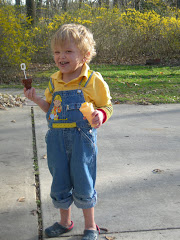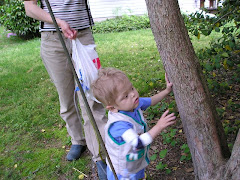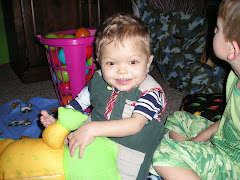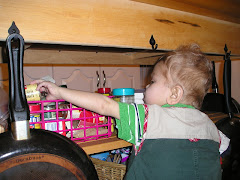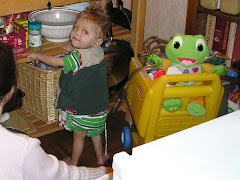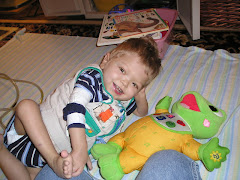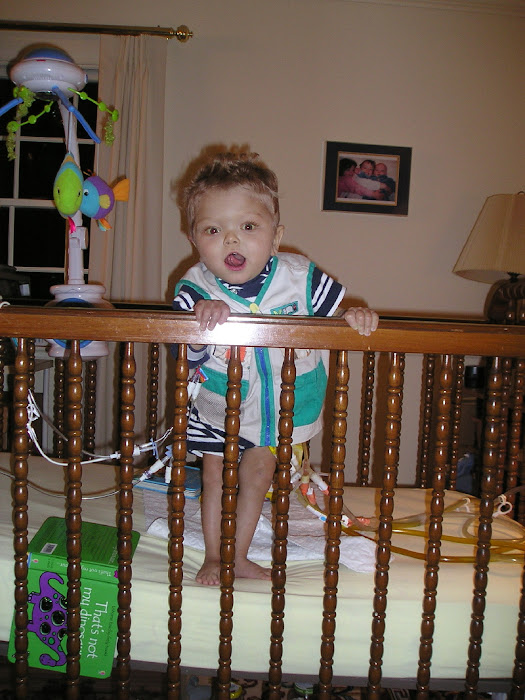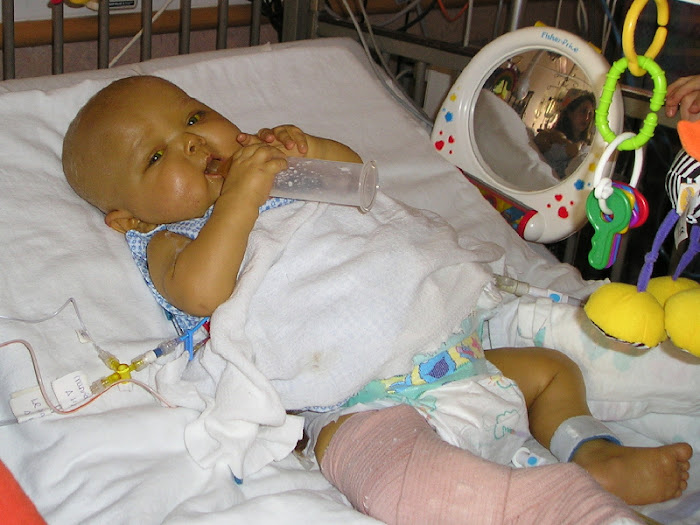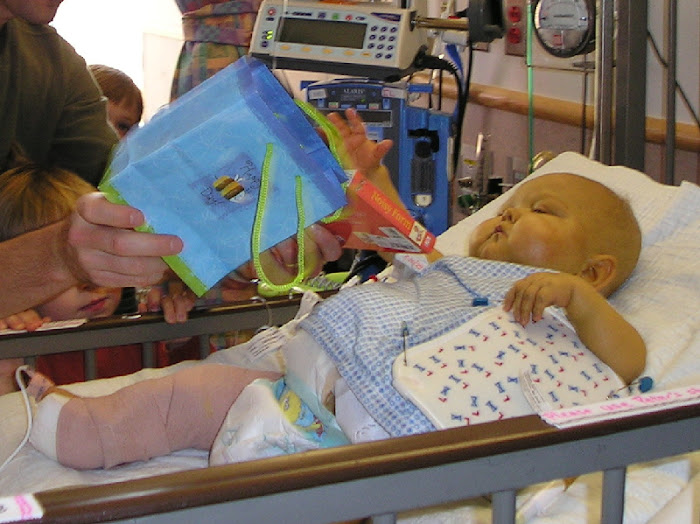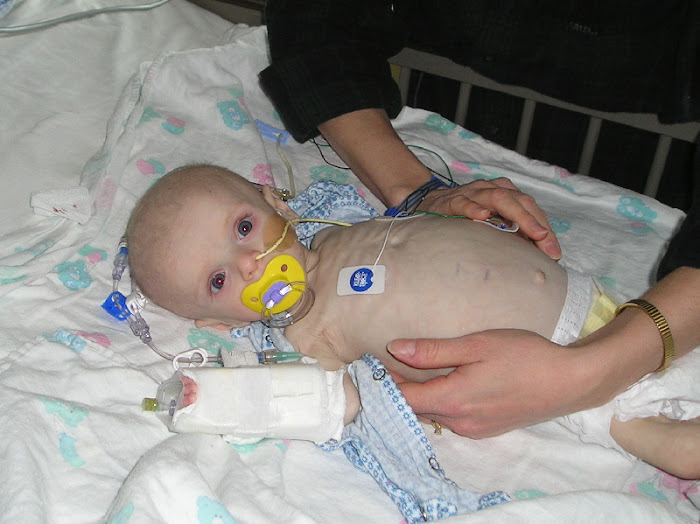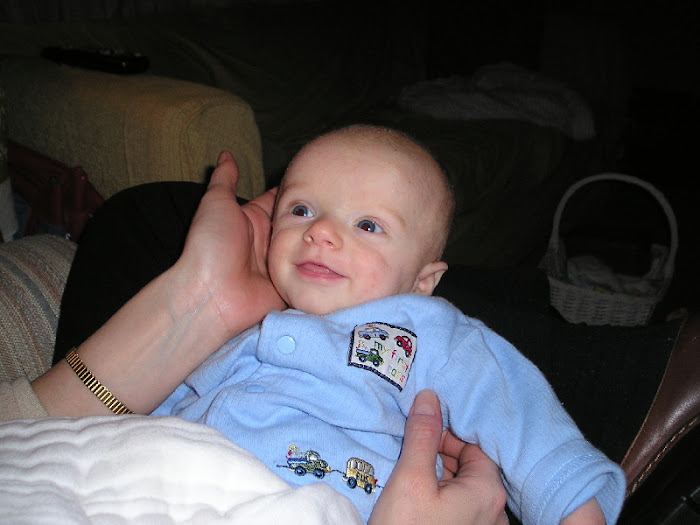Peter's last check up was great in terms of weight gain. His arm measurements indicated that the weight was real weight, not just fluid gain. We decided to give sprironolactone a try again. Spironolactone is a diuretic which should help Peter to lose some of the ascites fluid along with some of the sodium. That should then help us to be able to afford him a little more sodium in his diet without the extra fluid accumulation. It did not help the last time he tried it, but I can't figure out how to decrease sodium further, given that a significant part of his diet is yogurt and Lactaid, both of which have naturally occuring sodium in them. His formula is one of the lower sodium formulas. He eats only low sodium foods on top of that, and his TPN is as low in sodium as they can get it too. So, we are trying this diuretic again. I can't tell if it has helped, but it has not seemed to cause a problem at any rate.
He has been on ursodiol now for about a month, and that has seemed to be quite helpful with him digesting fat. The liver numbers seem to indicate that this med has helped as well. Ursodiol is a bile salt, and is often used in gall bladder disease and in TPN cholestasis. I think it may be used for short gut as well, but not totally sure of that.
Vitamin D levels indicate that his levels are still is too low on 2000 IU/day, so he is now going up to 10,000 IU/day for 6 weeks to rebuild his levels. His dexa scan two months ago indicates that he still has osteopenia, which is one of the downsides to long term TPN.
So the down side to the visit is that Peter's spleen is considerably larger by physical exam than it was back in February when the last endoscopy was done to band off enlarged esophageal varices. ( I see that I forgot to post about that, but basically he had a scope done to check for large varices and Dr. Kamin did end up banding two of them that were a little large. This was done as follow up to the bleed he had after his fistula surgery last Fall.) Peter was due to have another scope in August, again as follow up, but in light of the spleen size and the platelet decrease, he wants Peter back sooner to rescope and check for new or enlarged varices. Instead of returning in 8 weeks as hoped, we return in 3 weeks from the last visit. If the varices in the esophagus are very large, they can bleed and not stop. Banding can be done to shrink the varices and keep that situation from occurring. Meanwhile, we are looking into what can be done about the spleen itself. Peter's platelet count has been in the low 30,000 range the past couple months. He is not bleeding, but the number can't get too much lower without real concern for spontaneous bleeding. A splenectomy is likely not a possibility, but there may be a way to embolize the circulation to it to decrease its size and restore the platelet and white count values to more normal levels. The procedure is called a partial splenic embolization. We should know more about i,t and whether it is the route to go with Peter's spleen, after this trip.
Peter is getting a little tired of the trip lately. It is hard for him to understand why we need to keep going up there. He used to love the trip, but we are going so often over the last year, that there isn't much time to build up anticipation for the next trip. We should get to a point again where the trips space out further, and we are just viewing this as more bumps in the road, but I will have to figure out new ways to make the trip fun again.
Monday, June 25, 2012
Bilirubin-stained teeth
We have been making the circuit with dentists, trying to find out what to do to improve the look of Peter's teeth. We've been to three so far, each one further away than the last. The last one took two hours to get to, but has a great reputation and I know him from years ago.
Peter's front top two teeth, and bottom four teeth, are slate-gray, with some tea-brown color at the tips. These are his permanent teeth. His baby teeth are discolored as well, but not quite as dramatically. The discoloration is due to sustained elevated bilirubin that occurred during infancy as his teeth were still in formation. He had high bilirubin for many months, sometimes with levels in the mid to upper 20s range sustained.
The latest dentist took photos of Peter's teeth and gave a copy to me. I'll post them with this blog one of these days soon.
Omegaven helped his liver, thereby bringing down the bilirubin levels, and ultimately kept him from needing a multivisceral transplant. Usually a child with this level of bilirubin has either succombed to the liver illness or has gone on for liver transplant.
The dentists are puzzled with what to do for someone like Peter who has pulled through such a long illness. We may be looking at veneers, but there is concern that in a six year old child they will not have a long life before needing to be redone where the gumline becomes visible as the child grows. There is also concern that the veneers will pop off and he could aspirate them. The veneers would be done without the usual preparation so that they will be stronger and able to withstand the probable braces he needs as well. Bleach is not an option unless it is done after a root canal so the teeth could be bleached from within. That then leaves a person with dead teeth though, and that is not a great option either. As an adult, he will likely get veneers or crowns and they will last many years, but as a child the gumline apparently recedes some every year until adulthood. (In addition to ostomies, wound vacs, TPN, and such, I am learning a lot about teeth through Peter's illness too!)
The latest dentist suggested that if Peter is OK with his teeth color, which he is so far, then maybe just let the teeth be until he becomes concerned about it. As I type that, I realize that advice sounds cold, but he did not mean it that way. His concern was that it may be in Peter's best interest to leave the teeth be so that when he is able to have something done for them on a more permanent basis, he has strong teeth to work with. Meanwhile, both dentists that gave us advice are continuing to look for more solutions to this problem. They have been consulting colleagues across the country and have been very compassionate about Peter's situation.
With both of the pediatric dentists we have seen over the last 3 weeks, I have been close to tears with their kindness and empathy. They both clearly have that great quality that we have seen in Dr. Kamin and Dr. Jennings, which is to take that child's situation and own it and repeatedly work on finding a solution, regardless of the inconvenience to oneself. God has put such kind, compassionate people in our lives and it is humbling as well as reaffirming of the goodness of others.
UPDATE: I realize that I never did end up posting this and it has been a month now. The dentist who suggested that we do nothing contacted me late last week and said that he has had Peter on his mind since he saw him, and has called colleagues all over the nation. He said that he still thinks our best bet to save Peter's teeth so they can make it into adulthood in good condition and ready to crown would be to do really nothing for now. He said there is an appliance called Snap-on-Smile, which would cosmetically cover all of his teeth, but not actually change them. He then offered to call the other more local dentist to discuss it with him as an option instead of veneers. I'll keep sharing what I find out.
Peter's front top two teeth, and bottom four teeth, are slate-gray, with some tea-brown color at the tips. These are his permanent teeth. His baby teeth are discolored as well, but not quite as dramatically. The discoloration is due to sustained elevated bilirubin that occurred during infancy as his teeth were still in formation. He had high bilirubin for many months, sometimes with levels in the mid to upper 20s range sustained.
The latest dentist took photos of Peter's teeth and gave a copy to me. I'll post them with this blog one of these days soon.
Omegaven helped his liver, thereby bringing down the bilirubin levels, and ultimately kept him from needing a multivisceral transplant. Usually a child with this level of bilirubin has either succombed to the liver illness or has gone on for liver transplant.
The dentists are puzzled with what to do for someone like Peter who has pulled through such a long illness. We may be looking at veneers, but there is concern that in a six year old child they will not have a long life before needing to be redone where the gumline becomes visible as the child grows. There is also concern that the veneers will pop off and he could aspirate them. The veneers would be done without the usual preparation so that they will be stronger and able to withstand the probable braces he needs as well. Bleach is not an option unless it is done after a root canal so the teeth could be bleached from within. That then leaves a person with dead teeth though, and that is not a great option either. As an adult, he will likely get veneers or crowns and they will last many years, but as a child the gumline apparently recedes some every year until adulthood. (In addition to ostomies, wound vacs, TPN, and such, I am learning a lot about teeth through Peter's illness too!)
The latest dentist suggested that if Peter is OK with his teeth color, which he is so far, then maybe just let the teeth be until he becomes concerned about it. As I type that, I realize that advice sounds cold, but he did not mean it that way. His concern was that it may be in Peter's best interest to leave the teeth be so that when he is able to have something done for them on a more permanent basis, he has strong teeth to work with. Meanwhile, both dentists that gave us advice are continuing to look for more solutions to this problem. They have been consulting colleagues across the country and have been very compassionate about Peter's situation.
With both of the pediatric dentists we have seen over the last 3 weeks, I have been close to tears with their kindness and empathy. They both clearly have that great quality that we have seen in Dr. Kamin and Dr. Jennings, which is to take that child's situation and own it and repeatedly work on finding a solution, regardless of the inconvenience to oneself. God has put such kind, compassionate people in our lives and it is humbling as well as reaffirming of the goodness of others.
UPDATE: I realize that I never did end up posting this and it has been a month now. The dentist who suggested that we do nothing contacted me late last week and said that he has had Peter on his mind since he saw him, and has called colleagues all over the nation. He said that he still thinks our best bet to save Peter's teeth so they can make it into adulthood in good condition and ready to crown would be to do really nothing for now. He said there is an appliance called Snap-on-Smile, which would cosmetically cover all of his teeth, but not actually change them. He then offered to call the other more local dentist to discuss it with him as an option instead of veneers. I'll keep sharing what I find out.
Subscribe to:
Comments (Atom)

